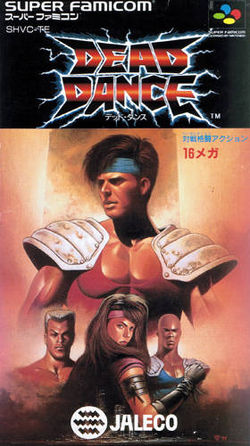- Tuff E Nuff
-
Tuff E Nuff
Dead Dance
Japanese cover artDeveloper(s) Jaleco Publisher(s) Jaleco Composer(s) Yasuhiko Takashiba
Suguru IshidaPlatform(s) Super NES Release date(s) Genre(s) Fighting Mode(s) Single-player
MultiplayerMedia/distribution Cartridge Tuff E Nuff, fully titled as Hey Punk! Are You Tuff E Nuff? and known in Japan as Dead Dance (デッドダンス), is a 1993 head-to-head fighting game produced by Jaleco for the Super Nintendo.
Contents
Plot
The story is set in a post apocalyptic Earth in the year AD 2151. To the inhabitants on Earth it seems like the only chance for a decent life is to fight, in a "survival of the fittest" scenario. A man named Jado finds a powerful blue fighting armor and calls himself "The Fighting King". With it, he quickly gains control of the world. Using his newfound power, he erects a tower with six guards. Many try to take Jado's power away, but unfortunately, they die in their attempt. Some weeks after the building of the tower, a tournament is held all over the world to see who is the strongest. Of the many fighters, only four people are chosen. Now they need to fight each other to see who is going in the tower.
The plot-dialogues of the Story mode, the final epilogues were excluded from the North American and European versions.
Box Art
The original Japanese cover art to Dead Dance/Tuff E Nuff is taken from a issue cover of the UK gaming magazine, Computer and Video Games. CVG created the artwork for their preview feature as there was none available at the time. Jaleco were so impressed with the design, they asked CVG to make it the official artwork for the game. It appears on the Japanese and European versions of the game.
Jaleco USA decided to use their own box art instead for the American release which is often considered to be one of the worst designs for a video game of all time. It can be seen in the first level of the original arcade version of Jaleco's Game Tengoku.
Gameplay
The game can be played with one to two real players. The game starts off with only four characters, but a Boss Code can unlock the other seven characters. The game has three modes: Story Mode, 1-Player to CPU Mode, and Multiplayer Mode. The fighting engine is a traditional style, 4-button engine. The B and A buttons are the kicks, being light and fierce respectively, and the Y and X buttons are the punches, light and fierce respectively. All characters have at least two special attacks. In all modes, the more life anyone loses, the more bloody the characters' faces become, much like in SNK's Art of Fighting series; however, like the final epilogues of the main characters, were removed from the North American and European versions.
There are ten stages in story mode, where either Syoh, Zazi, Kotono and Vortz fight. After picking a character, the player must fight the other three in a tournament-style fashion. After fighting the other heroes, the player must fight the six guards leading to Jado. After fighting Jado, there is an ending sequence (only in the Japanese version) followed by a screen saying to go to hard mode, or a congratulations for the completion of beating hard mode. After beating hard mode, the closing credits show a clip of the players' battles with the enemies faced. The four main characters' skills evolve over story mode, featuring a RPG-like element, meaning their special moves become slightly larger and more powerful after each group of opponents are defeated.
Characters
- Playable characters
- Syoh - From Hokkaidō, Japan. His fighting style is called Tenga Haouryuu (Heavenly Claw).
- Zazi - From the United States. His fighting style is Chisou Haouryuu (Earth Claw). He is a head swap of Syoh.
- Kotono - From Kyoto, Japan. Her fighting style is Kuki Shindenryuu Ninjutsu. She wields kunai daggers.
- Vortz - From Holland. His fighting style is wrestling. (Although this is unofficial, Vortz have some similitudes with Rutger Hauer and his Jugger character from The Blood of Heroes, this fact can be noted better on the Japanese version's box art.)
- CPU Opponents
- Beans - A punk street fighter from Bronx, New York.
- Dolf - A covert operations specialist from Libya.
- Rei - A kenpō expert, also from Japan. Rei has the ability to summon spirits which aid her in combat.
- Gajet - A wrestler from unknown origins. He is actually a former friend of Vortz.
- Sirou - A ninja from Japan.
- K's - A cyborg from Germany. His weapon of choice is his bionic arms, which gives him good range on attacks.
- Jado/Jade - The self-proclaimed Fighting King and the final boss.
References
- ^ Dead Dance / Tuff E Nuff at Jaleco's website
External links
- Dead Dance at Jaleco (Japanese)
- Tuff E Nuff at MobyGames
- Tuff E Nuff at GameFAQs
Categories:- 1993 video games
- Jaleco games
- Post-apocalyptic video games
- Science fiction video games
- Super Nintendo Entertainment System games
- Versus fighting games
- Video games developed in Japan
Wikimedia Foundation. 2010.
